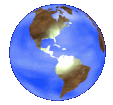Satellites | Gallery | Links
![]()
This page was constructed to educate my partner and myself, as well as, our remote sensing class on how remote sensing can be used to study volcanoes. Being our final project for the class we wanted to apply some of the technologies that we have learned about and how they are implemented in real life. We chose three different platforms. The main concentration of this page is Radar Imaging but we do show how thermal and false color infrared are used. We discovered something unexpected and is that weather satellites, such as GOES 3, can be used to monitor volcanic eruptions. At this point we would like to thank you for stopping by our web page and hope that it gets you to where you want to go.
Why should we use remote sensing to study volcanoes?
Safety
With more people living near active volcanoes remote sensing is used to monitor changes in elevation, thermal and particle emissions.
Accessibility to volcanoes is often difficult and limited.
Hazardous gases emissions and volcanic emissions ex. lava, hot ash etc.
Accuracy
Monitor minor changes of elevation over a wide area due to sub-surface forces
Often detecting changes that are not visible to the human eye.
Track the increase of thermal emissions.
Measure changes of vegetation near volcanoes.
Time Saving
Satellite radar imaging could be done faster than field survey.
Fast recognition of ground changes.
Easier than trying to access the area by conventional means.

This web page
is by
Darsana and Mark
Salem State Collage Geography Students
Salem State Digital Geography Lab